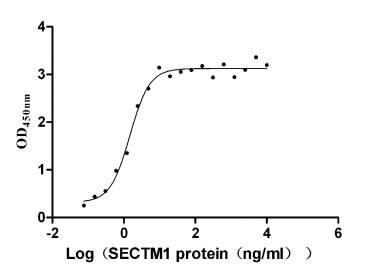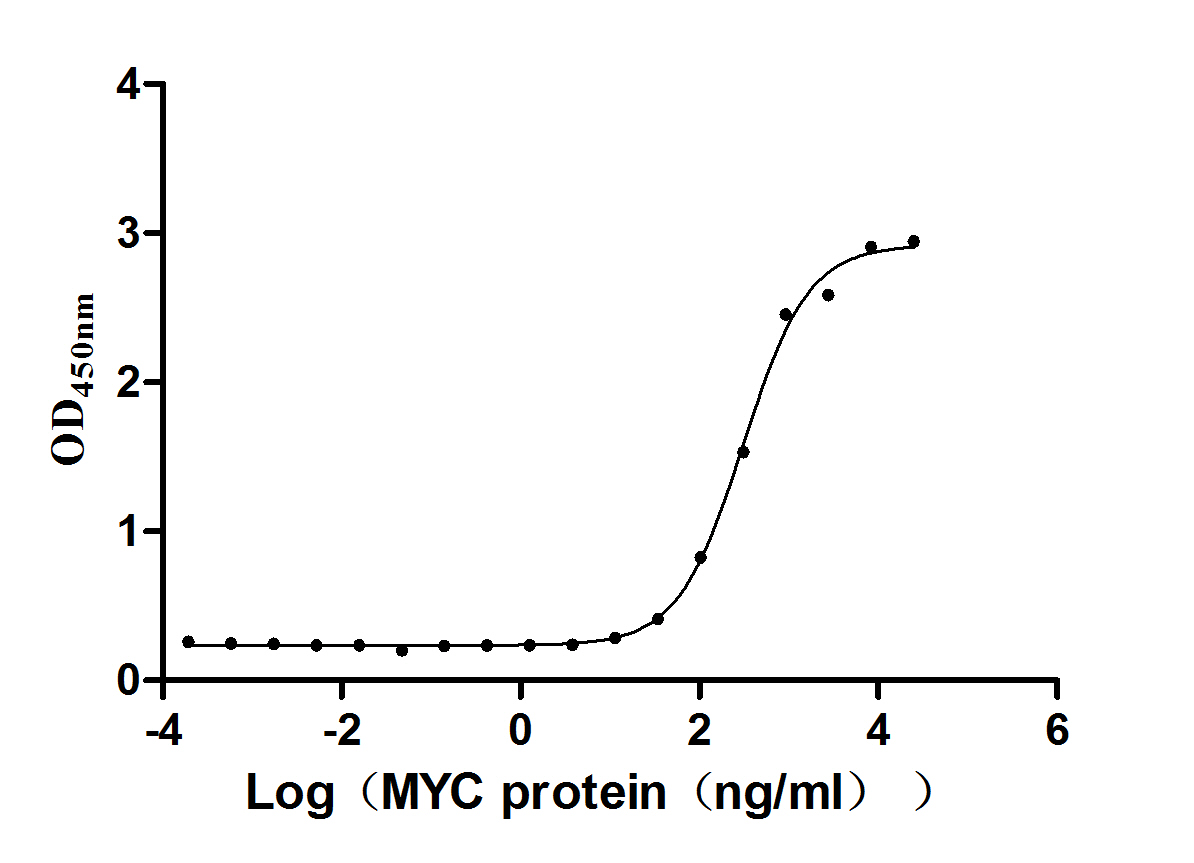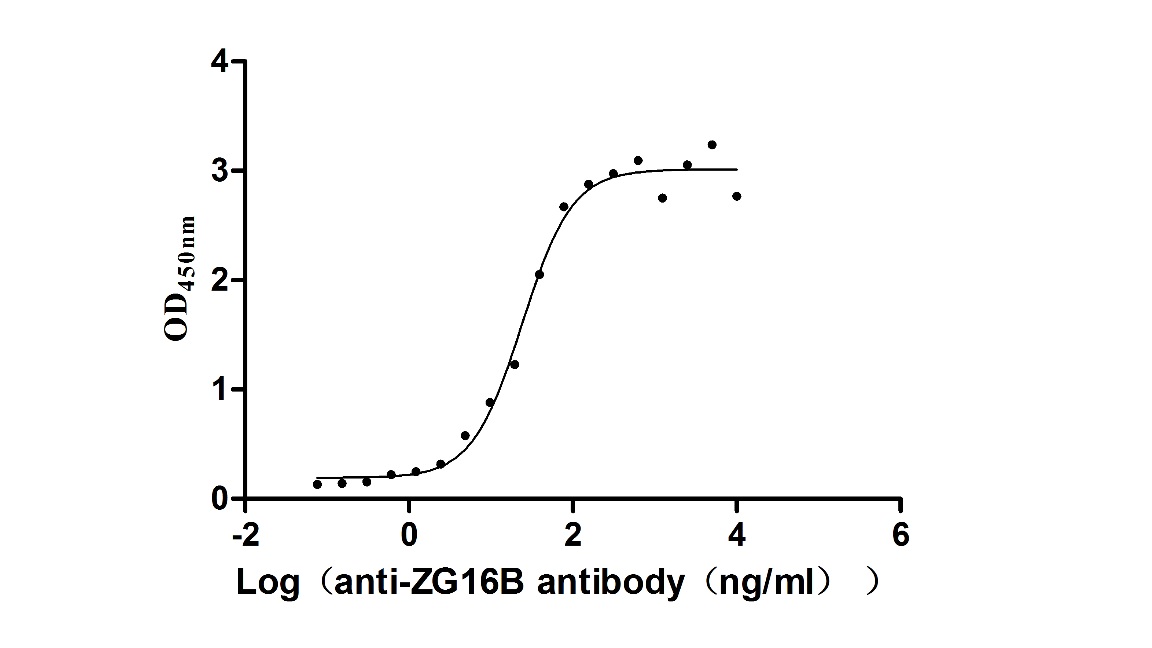Recombinant Mouse Glucagon (Gcg), partial
-
货号:CSB-YP009315MO
-
规格:
-
来源:Yeast
-
其他:
-
货号:CSB-EP009315MO
-
规格:
-
来源:E.coli
-
其他:
-
货号:CSB-EP009315MO-B
-
规格:
-
来源:E.coli
-
共轭:Avi-tag Biotinylated
E. coli biotin ligase (BirA) is highly specific in covalently attaching biotin to the 15 amino acid AviTag peptide. This recombinant protein was biotinylated in vivo by AviTag-BirA technology, which method is BriA catalyzes amide linkage between the biotin and the specific lysine of the AviTag.
-
其他:
-
货号:CSB-BP009315MO
-
规格:
-
来源:Baculovirus
-
其他:
-
货号:CSB-MP009315MO
-
规格:
-
来源:Mammalian cell
-
其他:
产品详情
-
纯度:>85% (SDS-PAGE)
-
基因名:
-
Uniprot No.:
-
别名:GcgGlucagon [Cleaved into: Glicentin; Glicentin-related polypeptide; GRPP); Oxyntomodulin; OXM; OXY); Glucagon; Glucagon-like peptide 1; GLP-1); Glucagon-like peptide 1(7-37; GLP-1(7-37)); Glucagon-like peptide 1(7-36; GLP-1(7-36)); Glucagon-like peptide 2; GLP-2)]
-
种属:Mus musculus (Mouse)
-
蛋白长度:Partial
-
表达区域:21-89
-
氨基酸序列HALQDTEENP RSFPASQTEA HEDPDEMNED KRHSQGTFTS DYSKYLDSRR AQDFVQWLMN TKRNRNNIA
-
蛋白标签:Tag type will be determined during the manufacturing process.
The tag type will be determined during production process. If you have specified tag type, please tell us and we will develop the specified tag preferentially. -
产品提供形式:Lyophilized powder
Note: We will preferentially ship the format that we have in stock, however, if you have any special requirement for the format, please remark your requirement when placing the order, we will prepare according to your demand. -
复溶:We recommend that this vial be briefly centrifuged prior to opening to bring the contents to the bottom. Please reconstitute protein in deionized sterile water to a concentration of 0.1-1.0 mg/mL.We recommend to add 5-50% of glycerol (final concentration) and aliquot for long-term storage at -20℃/-80℃. Our default final concentration of glycerol is 50%. Customers could use it as reference.
-
储存条件:Store at -20°C/-80°C upon receipt, aliquoting is necessary for mutiple use. Avoid repeated freeze-thaw cycles.
-
保质期:The shelf life is related to many factors, storage state, buffer ingredients, storage temperature and the stability of the protein itself.
Generally, the shelf life of liquid form is 6 months at -20°C/-80°C. The shelf life of lyophilized form is 12 months at -20°C/-80°C. -
货期:Delivery time may differ from different purchasing way or location, please kindly consult your local distributors for specific delivery time.Note: All of our proteins are default shipped with normal blue ice packs, if you request to ship with dry ice, please communicate with us in advance and extra fees will be charged.
-
注意事项:Repeated freezing and thawing is not recommended. Store working aliquots at 4°C for up to one week.
-
Datasheet :Please contact us to get it.
相关产品
靶点详情
-
功能:Plays a key role in glucose metabolism and homeostasis. Regulates blood glucose by increasing gluconeogenesis and decreasing glycolysis. A counterregulatory hormone of insulin, raises plasma glucose levels in response to insulin-induced hypoglycemia. Plays an important role in initiating and maintaining hyperglycemic conditions in diabetes.; Potent stimulator of glucose-dependent insulin release. Also stimulates insulin release in response to IL6. Plays important roles on gastric motility and the suppression of plasma glucagon levels. May be involved in the suppression of satiety and stimulation of glucose disposal in peripheral tissues, independent of the actions of insulin. Has growth-promoting activities on intestinal epithelium. May also regulate the hypothalamic pituitary axis (HPA) via effects on LH, TSH, CRH, oxytocin, and vasopressin secretion. Increases islet mass through stimulation of islet neogenesis and pancreatic beta cell proliferation. Inhibits beta cell apoptosis (Probable).; Stimulates intestinal growth and up-regulates villus height in the small intestine, concomitant with increased crypt cell proliferation and decreased enterocyte apoptosis. The gastrointestinal tract, from the stomach to the colon is the principal target for GLP-2 action. Plays a key role in nutrient homeostasis, enhancing nutrient assimilation through enhanced gastrointestinal function, as well as increasing nutrient disposal. Stimulates intestinal glucose transport and decreases mucosal permeability.; Significantly reduces food intake. Inhibits gastric emptying in humans. Suppression of gastric emptying may lead to increased gastric distension, which may contribute to satiety by causing a sensation of fullness.; May modulate gastric acid secretion and the gastro-pyloro-duodenal activity. May play an important role in intestinal mucosal growth in the early period of life.
-
基因功能参考文献:
- Data suggest that Tas1r2 and Tas1r3 are involved in regulation of Glp1 secretion in enteroendocrine cells; 3DG (3-deoxyglucosone) attenuates high glucose-stimulated Glp1 secretion by antagonizing Tas1r2/Tas1r3 subunits and downstream cAMP signaling. (Tas1r2 = sweet taste receptor subunit Tas1r2; Tas1r3 = sweet taste receptor subunit Tas1r3; Glp1 = glucagon-like peptide-1) PMID: 29277113
- GPR119 is the oleoyl-lysophosphatidylinositol receptor that is required for GLP-1 secretion in enteroendocrine cells. PMID: 29883799
- data show that the CREB/CRTC2-dependent transcriptional pathway is critical for regulating glucose homeostasis by controlling production of GLP-1 from the L cells at the level of transcription, maturation, and exocytosis. PMID: 29118086
- the results of the present study indicated that GLP1 may be a promising target for the development of novel therapeutic strategies for HGinduced nephropathy, and may function through the activation of SIRT1 PMID: 29845208
- this study, we investigated whether glucagon and glucagon-like peptide-1 (GLP-1), hormones produced by alpha cells, contribute to insulin secretion in INS-1 cells, a beta cell line. Co-treatment with glucagon and exendin-4 (Ex-4), a GLP-1 receptor agonist, additively increased glucose-stimulated insulin secretion in INS-1 cells PMID: 29725251
- results show that glucagon controls gene expression and metabolic zonation in the liver through a counterplay with the Wnt/beta-catenin signaling pathway. PMID: 29555772
- Data (including data from studies using transgenic and knockout mice) suggest that Glp1/Glp1r signaling in insulin-secreting cells plays important role in development of glucose intolerance in obesity; however, Glp1r is not required in insulin-secreting cells for improvement in glucose intolerance after weight loss due to bariatric surgery (here, vertical sleeve gastrectomy). PMID: 29759973
- Data suggest that metabolism of glutamine and related analogs by Gdh in intestinal L-cells explains why Glp1 secretion, but not that of insulin by pancreatic beta-cells, is activated by these secretagogues. (Gdh = glutamate dehydrogenase; Glp1 = glucagon-like peptide 1) PMID: 29229616
- Glucokinase governs an alpha-cell metabolic pathway that suppresses secretion at or above normoglycemic levels; abnormal suppression of glucagon secretion deregulates hepatic glucose metabolism and, over time, induces a pre-diabetic phenotype. PMID: 29416045
- in colonic crypt cultures, the GLP-1 secretion induced by such Gq + Gs GPR40 agonists is indeed inhibited by blockers of both Gq and Gs and is eliminated by combining these. PMID: 27908836
- Enteric GLP-1 activates NO production by enteric neurons that is impaired in type 2 diabetes. Gut microbiota dysbiosis induces enteric neuropathy. Gut microbiota dysbiosis is responsible for the GLP-1 resistance. PMID: 28467926
- of glucagon-like peptide-1 in vagotomized mice may prevent VLDL overproduction and insulin resistance induced by high-fat diet. PMID: 29074588
- beta-cell function, plasma active GLP-1 levels, the GLP-1R pathway in beta cells and L cell differentiation, were investigated. PMID: 27436347
- The role of syntaxin 1A in GLP1 release from intestinal cells as a response to external stimuli is reported. PMID: 28596237
- GCG neurons likely stimulate separate populations of downstream cells to produce a change in food intake and glucose homeostasis and that these effects depend on the metabolic state of the animal. PMID: 28218622
- Together, our data indicate effects of AgoPAMs that go beyond glucose lowering previously observed with GPR40 partial agonist treatment with additional potential for weight loss. PMID: 28292762
- pancreatic reactivation of Gcg fully restored the effect of exendin-[9-39] to impair both oral and intraperitoneal glucose tolerance. PMID: 28325479
- These findings suggest that TRPV2 activation via actin reorganization induced by Gq and G12/13 signaling is involved in LPI-stimulated GLP-1 secretion in enteroendocrine L cells. PMID: 28533434
- These results show novel ex vivo effects of rebaudioside A on enteroendocrine cells of the mouse small intestine and highlight potentially new applications for rebaudioside A in metabolic diseases. PMID: 27798332
- critical for the regulation of glucagon secretion in response to glucose in obesity PMID: 27547850
- These results strongly suggest that incretins upregulate the TNF-alpha-stimulated IL6 synthesis in osteoblasts, and that the amplifying effect of incretin is exerted via reducing the IkappaB/NFkappaB pathway through the adenylyl cyclase-cAMP system. PMID: 28204823
- These results indicated that 5rolGLP-HV had dual-function in treating diabetes and preventing thrombosis. PMID: 26780765
- Glucagon-like peptide-1 regulates calcium homeostasis and electrophysiological activities in cultured cardiomyocytes. PMID: 26930508
- GLP-1 release is altered in intestinal cultures from a high fat diet-fed mice. PMID: 26145551
- Data show that ginsenoside Rg3 stimulated glucagon-like peptide-1 (GLP-1) secretion in NCI-H716 enteroendocrine cells. PMID: 26675132
- GPR119 in L-cells plays a key role in oral lipid-triggered GLP-1 secretion. PMID: 26144594
- AMPK antagonizes hepatic glucagon signalling via phosphorylation-induced PDE4B activation PMID: 26952277
- Deletion of AMPK alpha 1 and alpha 2 in proglucagon-expressing cells results in increased L-cell mass and elevated circulating GLP-1 levels. PMID: 27010458
- The results suggest that TGR5 activation mediates cross-talk between alpha- and beta-cells by switching from glucagon to GLP-1 to restore beta- cell mass and function under hyperglycemic conditions. PMID: 26757816
- the acute combined administration of the strongly insulinotropic GLP-1 and glucagon, both in vivo and in vitro, did not induce any additive or synergistic action on glucose-stimulated insulin secretion. PMID: 26119909
- Data (including data from studies in transgenic mice) suggest neurotensin/Nts, GLP-1, and peptide YY are closely co-expressed and co-secreted within enteroendocrine cells in ileum mucosa; however, Nts is stored in distinct/separate secretory granules. PMID: 26469136
- CEACAM2 regulates insulin secretion, at least in part, by a GLP-1-mediated mechanism, independent of confounding metabolic factors. PMID: 26586918
- These data suggest that GLP-1 released from NTS neurons can reduce highly palatable food intake by suppressing mesolimbic DA signaling. PMID: 26212334
- Neuronostatin acts via GPR107 to increase cAMP-independent PKA phosphorylation and proglucagon mRNA accumulation in pancreatic alpha-cells. PMID: 26561648
- Data indicate that GCGKO mice, lack all proglucagon-derived peptides, including glucagon and GLP-1 are animal model for studying the development, pathogenesis, and metastasis of pancreatic neuroendocrine tumors (panNETs). PMID: 26192435
- Data show that ileal sections were costained for glucagon-like peptide-1 (GLP-1) and tumor necrosis factor receptor TNFR1. PMID: 26270730
- Data show that the action of bile acids on -like peptide-1 (GLP-1) secretion is predominantly mediated by G protein-coupled bile acid receptor GPBAR1 (TGR5) located on the basolateral L-cell membrane. PMID: 26280129
- The PKC-dependent effect of GLP-1 on membrane potential and electrical activity was mediated by activation of Na(+)-permeable TRPM4 and TRPM5 channels by mobilization of intracellular Ca(2+) from thapsigargin-sensitive Ca(2+) stores PMID: 26571400
- It was suggested that increased ileal GPR119 is a potential mechanism by which GLP-1 secretion is enhanced in apoA-IV-/- mice. PMID: 26294669
- Hypoxia decreases GLP-1 secretion from the GLUTag cell line, and our findings suggest that the postprandial decrease in oxygen tension in the intestine attenuates GLP-1 secretion. PMID: 25832631
- In mice, food intake stimulates oxyntomodulin secretion from the gut, which resets liver transcription rhythms via induction of the core clock genes Per1 and 2. PMID: 25821984
- Suggest that endogenous GLP-2 may act as a protective factor against the dysregulation of the glucose metabolism that occurs in mice fed a high fat diet. PMID: 25967277
- synaptotagmin-7 is directly activated by GLP-1 signaling and may serve as a drug target for boosting insulin secretion. PMID: 26216970
- Glucocorticoid receptor activation in GLP-1-producing cells will diminish the secretory responsiveness of these cells to subsequent carbohydrate stimulation leading to diabetes. PMID: 25853863
- The patterns of colocalisation of the K cell marker, glucagon-like insulinotropic peptide, and the L cell markers, glucagon like peptide-1 and peptide YY, in enteroendocrine cells of the small intestine and colon of mouse and pig, were investigated. PMID: 25378285
- These data indicate that GLP-1 but not GIP is a key mediator of beta cell mass expansion and related adaptations in pregnancy, triggered in part by generation of intra-islet GLP-1. PMID: 24927416
- Data suggest that Firmicutes and Bacteroidetes potentially mediate insulin resistance through modulation of glucagon-like peptide 1 (GLP-1) secretion in obesity. PMID: 25713030
- Data suggest that glucagon-like peptide-1 (GLP-1) may be involved in normal sweet taste signal transmission. PMID: 25678625
- NUCB2/nesfatin-1 is co-localized with GLP-1 and GIP in small intestinal cells. Data support the hypothesis that nesfatin-1 is present in enteroendocrine cells and that it stimulates incretin secretion. PMID: 25930999
- results suggest that the fine-turning of GLP-1 secretion from enteroendocrine L cells is established by the balance between alpha1-, alpha2-, and beta-ARs activation PMID: 25843795
显示更多
收起更多
-
亚细胞定位:Secreted.; [Glucagon-like peptide 1]: Secreted.
-
蛋白家族:Glucagon family
-
组织特异性:[Glucagon]: Secreted in the A cells of the islets of Langerhans.; [Glucagon-like peptide 1]: Secreted in the A cells of the islets of Langerhans. Secreted from enteroendocrine L cells throughout the gastrointestinal tract. Also secreted in selected neuron
-
数据库链接:
KEGG: mmu:14526
STRING: 10090.ENSMUSP00000099794
UniGene: Mm.45494
Most popular with customers
-
Recombinant Human T-cell antigen CD7 (CD7), partial (Active)
Express system: Mammalian cell
Species: Homo sapiens (Human)
-
Recombinant Human papillomavirus type 16 Protein E7 (E7) (Active)
Express system: E.coli
Species: Human papillomavirus type 16
-
Recombinant Human Nectin-4 (NECTIN4), partial (Active)
Express system: Mammalian cell
Species: Homo sapiens (Human)
-
Recombinant Human Claudin-4 (CLDN4)-VLPs (Active)
Express system: Mammalian cell
Species: Homo sapiens (Human)
-
Recombinant Macaca fascicularis CD93 molecule (CD93), partial (Active)
Express system: Mammalian cell
Species: Macaca fascicularis (Crab-eating macaque) (Cynomolgus monkey)
-
Recombinant Mouse Complement component C1q receptor (Cd93), partial (Active)
Express system: Mammalian cell
Species: Mus musculus (Mouse)
-
Recombinant Human Desmoglein-3 (DSG3), partial (Active)
Express system: Baculovirus
Species: Homo sapiens (Human)
-
Recombinant Macaca fascicularis zymogen granule protein 16 homolog B (ZG16B) (Active)
Express system: Mammalian cell
Species: Macaca fascicularis (Crab-eating macaque) (Cynomolgus monkey)




















